Physical comparison of tigers and lions
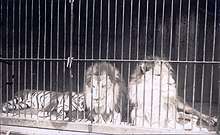
When discussing fights between lions and tigers, a physical comparison of them is often made. Generally, in terms of dimensions of the body and weight, the modern tiger[1] and lion[2] are the two largest species of the genus Panthera and the cat family. Variations in opinions and measurements exist for them, especially across different populations or subspecies.[3][4] Apart from that, similarities and differences exist for other characteristics, such as the lengths of their skulls.[5] As for their prehistoric relatives, such as the Ngandong tiger[6] and American lion,[7][8] they were considered to have been rather large, but measurements, estimates or opinions for their weights or sizes differ.
Weight

The tiger is normally viewed as being bigger than the lion.[1][5] However, there are firstly conflicting or different opinions or measurements on the weights or sizes of different populations or subspecies[9] lions and tigers,[6][10] such as whether or not:
- The Siberian tiger, or any other member of the species Panthera tigris,[10] weighed between 306 and 401 kg (675 and 884 pounds) in the wilderness,[5][11] and therefore, if the Caspian[12] or Siberian tiger was bigger[13][14] than the Bengal tiger.[lower-alpha 1]
- The Barbary lion (Panthera leo leo) of North Africa[5][15] was bigger[16][17][18] than the Cape or Southern African lion (Panthera leo melanochaita).[lower-alpha 2]
- The Southern African lion is bigger than the East African lion.[2]
- Asiatic lions[20][21] (P. l. leo)[lower-alpha 3] in the western region[23][24] were bigger than those in the southern region.[25][26]
It is hard to obtain reliable measurements for wild specimens,[27] and as a consequence, it is not always clear which populations or subspecies of tigers were bigger than those of lions, or vice versa.[9][1][3] In addition, putting together the recorded weights of different populations or subspecies of lions and tigers, it appears that on average in the wilderness, the tiger is not heavier than the lion. Therefore, if the former species is heavier than the latter species, then it would be due to the weights of individuals being higher in the former than in the latter.[28][6]
Vratislav Mazák (1981) said that the Bengal, Caspian and Siberian tigers ranked as the biggest felids in modern times,[1] therefore the largest of the genus Panthera.[29] The Caspian tiger was considered by Humphreys and Karhom (1999) to have been generally larger than its Indian relative, and almost like its Siberian relative, based on an analysis of skins and photographs.[12] The Siberian tiger was thought of as being the largest tiger[30][31] and felid in present times,[25][1][29] and Heptner and Sludskii mentioned recorded weights of up to 400 kilograms (880 lb) (Baikov, 1927). However, they also mentioned the possibility of exaggeration in these figures,[5] and not all measurements suggest that Caspian or Siberian tigers are the biggest tigers and felids, such as those on average weights of wild Bengal and Siberian tigers,[14][13][32] and Southern African lions in Kruger National Park, South Africa,[25][10][33] though it should be noted that even within recognized subspecies of lions[33][34] and tigers,[14] there can be significant differences in average weight, depending on the population or subpopulation. In addition, according to a number of other sources,[35][36][37][38][39] ligers can weigh well over 300 kg (660 pounds), and outsize tigers.
| Lion | Tiger |
|---|---|
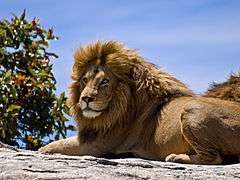 |
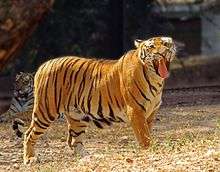 A couple of captive Bengal tigers |
|
Barring the Atlas lion and 'black-maned' Cape lion,[40][41][42] male African lions weighed[5][2] 150–226 or 249.5 kg (331–498 or 550 pounds), with some having exceeded 249.5 kg (550 lb) in the wilderness:[10][33][43]
Many people[50] considered the North African lion to have been the largest, most powerful lion and African felid.[17][51][52] It is difficult to know their exact weights, but Yamaguchi and Haddane (2002), using a small sample size available for study, estimated a range of 230–270 kg (510–600 pounds) for males,[52] and Beinglion.com[51] considered their range to be about 181.4–272 kg (400–600 pounds). According to some people, lions exceeding 272 kg (600 pounds) in weight were killed in Algeria (Pease, 1913, pages 91 – 92;[18] Bryden, 1899, pages 567 – 568).[53] Atlas was described by Gettysburg Compiler (1899) as being "much superior to the black-maned lions of South Africa in bulk and bravery."[17] The exceptional weights of some Barbary lions may have been due to them having fat bellies, at least after consuming prey, or a muscular build, in terms of chest-girth and the thickness of their thighs, for example.[51][17][18] According to Leyhausen (1975), with whom Hemmer visited purported Atlas lions in Morocco's Rabat Zoo in 1974, the North African lion's physique did include a deep chest.[25] However, Bryden (1899, page 567 – 568)[53] believed that on average, Atlas lions were not larger than other lions, barring huge specimens, and not all sources support the notion of Atlas lions being the largest of lions:[2][16][10]
As for captive African lions, there are accounts about some in the United States of America weighing 1,000 lb (450 kg).[59][60] Male Indian lions in the Gir Forest weighed 160–190 kg (350–420 pounds) (Nowell and Jackson, 1996).[2] There are accounts of exceptionally big Asiatic lions in both Gujarat[21][20] and former parts of their once great range,[25][26] such as an "unusually large" Persian individual that was melanistic, and was killed in Khuzistan in 1841,[23] though the genuinity of there being a melanistic lion in the wilderness was questioned by Sudipta Mitra (2005).[61] |
The average weight of males was reportedly 176.4 kilograms (388.9 lb) for the Siberian tiger, and 196 kilograms (432.1 lb) for the Bengal tiger.[14][13] The weight of 221 kilograms (487 lb) measured for the Bengal tiger in Chitwan National Park, Nepal, excluded any content in the stomach.[32] That said, on average in the wilderness, the Bengal tiger appears to be the heaviest of living tigers,[13] though it should be noted that tigers in Bengali Sundarbans can be much smaller than other Bengal tigers. The calculated average for male Sundarbans tigers was only 126 kilograms (278 lb). These tigers were deemed to have been 'frail', and without them, the average for the Bengal tiger would have been calculated as 208 kilograms (459 lb).[14]
|
| Lion | Tiger |
|---|---|
.jpg) |
 A Siberian tigress with a cub |
|
|
Length
| Lion | Tiger |
|---|---|
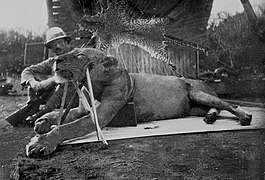 Colonel Patterson with the mounted body of one of the two man-eating East African lions of Tsavo in Kenya, 1898 |
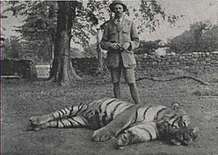 |
|
|
| Lion | Tiger |
|---|---|
|
Between the pegs, Siberian tigresses measured 2.40–2.75 metres (7.9–9.0 feet), Bengal tigresses measured 2.40–2.65 metres (7.9–8.7 feet), Caspian tigresses measured 2.40–2.60 metres (7.9–8.5 feet), Indochinese tigresses measured 2.30–2.55 metres (7.5–8.4 feet), South Chinese tigresses measured 2.20–2.40 metres (7.2–7.9 feet), Sumatran tigresses measured 2.15–2.30 metres (7.1–7.5 feet), and Bali tigresses measured 1.90–2.10 metres (6.2–6.9 feet) (Mazák, 1981).[1] |
Height at the shoulder
Lions have proportionately longer forelimbs than tigers. The lion's forelimb had a mean of 90% of the length of its hindlimb, whereas that tiger's forelimb had a mean of 86.5%.[6] From recorded measurements, it would appear that the Bengal[17] and Manchurian tigers,[10] and lion[67][68][61] are the tallest at the shoulder among living felids, apart from hybrids:[35][36][37][38][39]
| Lion | Tiger |
|---|---|
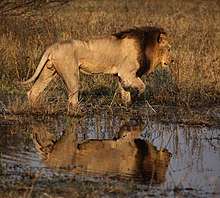 A Southern African lion walking in a swamp in the Okavango Delta of Botswana. Note that the body is taller at the front, before the head, than at the back, and that the physique of the Okavango lion is related to its lifestyle, which involves walking though water quite often.[34] |
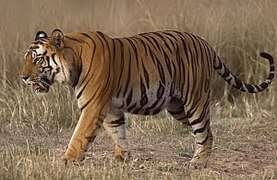 A Bengal tiger with a protruding shoulder at Bandhavgarh National Park, India |
|
|
Skull
Lions' skulls rival those of tigers in size[1] or length (Pease, 1913, page 101),[18] with the largest known skulls of tigers being slightly smaller than the largest known skulls of lions. Apart from size, the skulls are generally similar, with some differences in structural features of the lower jaw, relative length of the nose,[5] and the frontal regions.[4] In fact, the skulls of lions, especially from Asia, were so similar to those of tigers that Heptner and Sludskii[5] argued the novel opinion that the lion was closer to the tiger than to other animals like the leopard and jaguar.[71]
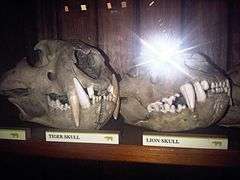 Comparison of tiger and lion skulls
Comparison of tiger and lion skulls Comparative illustration of tiger and lion skulls
Comparative illustration of tiger and lion skulls
| Lion | Tiger |
|---|---|
|
|
Cranial capacity
A study by Oxford University scientists has shown that overall, relative to body size, tigers have bigger brains than lions, leopards and jaguars. Although comparisons showed that lion skulls were larger overall, the tiger's cranial volume is the largest overall.[78] Even the skulls of small Balinese tigresses had volumes which were not less than those of bigger Kruger lions, which had longer skulls. In addition, the skulls of wild and captive tigers had similar volumes, but this did not apply to those African and Asian lions. The skulls of captive African lions had smaller volumes than those of their wild counterparts, and in contrast, those of captive Asiatic lions had higher volumes than those of their wild counterparts.[6][28]
| Lion | Tiger |
|---|---|
|
|
Schauenberg's index
Schauenberg's index is the skull's greatest length divided by its cranial volume. The tiger (1.093 ± 0.007) generally had a lower index than the lion (1.344 ± 0.006).[28]
| Lion | Tiger |
|---|---|
|
|
Bite force and teeth
Tigers have been shown to have higher average bite forces (such as at the canine tips) than lions.[79] The bite force adjusted for body mass allometry (BFQ) for tiger is 127, while that for lion is 112.[80] Tigers have well-developed sagittal crests and coronoid processes, providing muscle attachment for their strong bites. Tigers also have exceptionally stout teeth, and the canines are the longest and biggest among all living felids, measuring from 7.5 to 10 cm (3.0 to 3.9 in) in length, and are larger and longer than those of a similar-sized lion, probably because tigers need to bring down larger prey alone than lions, which usually hunt large prey in groups.[27][81] According to Heller, West African lions had longer carnassial teeth than Eastern and Southern African lions.[48]
Paw-swipe
- A swipe of a tiger's paw may crush a cow's skull.[82] Charles Frederick Partington (1835) said that Javan and Sumatran tigers, despite not being as heavy as Bengal tigers, were strong enough to break legs of horses or buffaloes with their paws.[3]
- Nevertheless, during the fight between the Shimlan tiger and Atlas the Barbary lion, though the tiger was quite massive and muscular, and its paw-swipes could be faster, they tended to be lighter than those of Atlas, according to Gettysburg Compiler (1899). For example, the tiger's paw-swipes could outnumber those of Atlas three-to-one, but Atlas' paw-swipes cut deeper wounds into the tiger's hide than those given to its hide by the tiger's paw-swipes.[17]
Roar
Lions and tigers, like other pantherid cats, are capable of roaring.[71] In a zoo, if a lion is near a tiger which gives a roar, then the lion may roar in response as it would to another lion. Though some people cannot distinguish between their roars,[4] there are differences.[3][1][83][84] Charles Frederick Partington, said that, in comparison, whereas a lion's roar would be loud and terrifying, but with 'grandeur', a tiger's cry would be 'horrid' and 'appalling', with a 'piercing' effect.[3] A similar description of the tiger's roar was given by Herne.[85]
Frequency
A male lion's roar can have a fundamental frequency of about 195 Hertz, whereas that of a lioness' roar may exceed 206 Hertz.[83]
In 2011, at Henry Doorly Zoo and Aquarium in Omaha, Nebraska, a study involving the larynges of three lionesses, a Sumatran tigress, a Bengal tigress, and a male Siberian tiger was done. They had been 15 to 22.4 years old at the times of their deaths. The range of frequencies produced was 10 to 430 hertz. Professor Tobias Riede of the University of Utah and National Center for Voice and Speech, who participated in the study, said that this was consistent with the known roaring frequencies of lions and tigers, which were 40 to 200 hertz and 83 to 246 hertz, respectively.[86]
Loudness
A tiger's roar can be heard up to 3 km (1.9 mi) away (Mazák, 1981).[1] A lion's roar can reach 114 decibels/meter (McComb et al. 1994; Peters and Wozencraft 1996),[2] and can be heard up to 5 km (3.1 mi) (Guggisberg 1975),[65] or at least 8 km (5.0 mi) away in optimal conditions (Sunquist & Sunquist, 2002), making it the loudest of the cat family.[25][83][84]
See also
Notes
- ↑ The Bengal, Caspian and Siberian tigers (respectively P. t. tigris, P. t. virgata and P. t. altaica)[1] were grouped by the Cat Specialist Group under P. t. tigris in 2017.[15]
- ↑ P. l. melanochaita is the taxonomic name for the Cape lion. In 2017, extant lions in Southern Africa (P. l. bleyenberghi, P. l. krugeri, and P. l. vernayi)[5][2] were subsumed by the Cat Specialist Group to P. l. melanochaita, unlike the North African lion.[15][19]
- ↑ Like the Senegal lion,[2] the relict population in India, that is Panthera leo persica, was subsumed by the Cat Specialist Group in 2017 to Panthera leo leo,[15] based on generally close relationships.[22]
- ↑ South Sudanese lions are genetically Central African lions, with some in the eastern part of the country being apparently genetically mixed between Central and Eastern African lions. The Nubian lion, from the region that is shared between Sudan and Egypt,[55] was genetically and taxonomically[56] linked with the Barbary lion.[57]
References
- 1 2 3 4 5 6 7 8 9 10 11 12 13 14 15 16 17 18 19 20 Mazák, V. (1981). "Panthera tigris" (PDF). Mammalian Species. 152 (152): 1–8. doi:10.2307/3504004. JSTOR 3504004. Archived from the original (PDF) on 9 March 2012.
- 1 2 3 4 5 6 7 8 9 10 11 Haas, S.K.; Hayssen, V.; Krausman, P.R. (2005). "Panthera leo" (PDF). Mammalian Species. 762: 1–11. doi:10.1644/1545-1410(2005)762[0001:PL]2.0.CO;2. Archived from the original (PDF) on 28 July 2017.
- 1 2 3 4 5 6 7 Charles Frederick Partington (1835). "Felis, the cat tribe". The British cyclopæedia of natural history. Orr & Smith.
- 1 2 3 4 5 Pocock, R. I. (1939). The Fauna of British India, including Ceylon and Burma. Mammalia. – Volume 1. Taylor and Francis Ltd., London. Pp. 197–222.
- 1 2 3 4 5 6 7 8 9 10 11 12 13 14 15 16 Heptner, V. G.; Sludskii, A. A. (1992) [1972]. Mlekopitajuščie Sovetskogo Soiuza. Moskva: Vysšaia Škola [Mammals of the Soviet Union, Volume II, Part 2]. Washington DC: Smithsonian Institution and the National Science Foundation. pp. 83–202. ISBN 90-04-08876-8.
- 1 2 3 4 5 6 7 8 9 10 Ronald Tilson, Philip J. Nyhus (2010), "Tiger morphology", Tigers of the world, Academic Press, ISBN 978-0-8155-1570-8
- ↑ DeSantis, L. R.; Schubert, B. W.; Scott, J. R.; Ungar, P. S. (2012). "Implications of diet for the extinction of saber-toothed cats and American lions". PLoS ONE. 7 (12): e52453. Bibcode:2012PLoSO...752453D. doi:10.1371/journal.pone.0052453. PMC 3530457. PMID 23300674.
- ↑ Merriam, J. C. & Stock, C. 1932: The Felidae of Rancho La Brea. Carnegie Institution of Washington Publications 442, 1–231.
- 1 2 Packer, C. "Frequently asked questions". University of Minnesota Lion Research Project. Retrieved 28 June 2011.
- 1 2 3 4 5 6 7 8 9 10 11 12 Wood, G. L. (1983). The Guinness Book of Animal Facts and Feats. Sterling Publishing. ISBN 978-0-85112-235-9.
- 1 2 3 4 Mazak, V. (2004). Der Tiger. Westarp Wissenschaften Hohenwarsleben. ISBN 3-89432-759-6. (in German)
- 1 2 Humphreys, P., Kahrom, E. (1999). Lion and Gazelle: The Mammals and Birds of Iran. Images Publishing, Avon.
- 1 2 3 4 Slaght, J. C., D. G. Miquelle, I. G. Nikolaev, J. M. Goodrich, E. N. Smirnov, K. Traylor-Holzer, S. Christie, T. Arjanova, J. L. D. Smith, Karanth, K. U. (2005) Chapter 6. Who‘s king of the beasts? Historical and recent body weights of wild and captive Amur tigers, with comparisons to other subspecies. Pages 25–35 in: Miquelle, D.G., Smirnov, E.N., Goodrich, J.M. (Eds.) Tigers in Sikhote-Alin Zapovednik: Ecology and Conservation. PSP, Vladivostok, Russia (in Russian)
- 1 2 3 4 5 6 Valvert L., Raúl A. "Weight of the Bengal tiger (Panthera tigris tigris)". Retrieved 2016-06-28.
- 1 2 3 4 Kitchener, A. C.; Breitenmoser-Würsten, C.; Eizirik, E.; Gentry, A.; Werdelin, L.; Wilting, A.; Yamaguchi, N.; Abramov, A. V.; Christiansen, P.; Driscoll, C.; Duckworth, J. W.; Johnson, W.; Luo, S.-J.; Meijaard, E.; O’Donoghue, P.; Sanderson, J.; Seymour, K.; Bruford, M.; Groves, C.; Hoffmann, M.; Nowell, K.; Timmons, Z.; Tobe, S. (2017). "A revised taxonomy of the Felidae: The final report of the Cat Classification Task Force of the IUCN Cat Specialist Group" (PDF). Cat News (Special Issue 11).
- 1 2 3 4 Jardine, W. (1834). The Naturalist's Library. Mammalia Vol. II: the Natural History of Felinae. W. H. Lizars, Edinburgh.
- 1 2 3 4 5 6 7 8 "Lion against tiger". Gettysburg Compiler. 7 February 1899. Retrieved 2016-02-28.
- 1 2 3 4 5 6 Pease, A. E. (1913). The Book of the Lion. London: John Murray.
- ↑ Henschel, P.; Bauer, H.; Sogbohoussou, E. & Nowell, K. (2016). "Panthera leo (West Africa subpopulation". IUCN Red List of Threatened Species. Version 2016.2. International Union for Conservation of Nature.
- 1 2 Charles Knight, ed. (1867). The English Cyclopaedia. Retrieved 2014-08-28.
- 1 2 The Penny Cyclopædia of the Society for the Diffusion of Useful Knowledge. 14. Charles Knight and Co. 1846-01-09. Retrieved 2014-08-28.
- ↑ Antunes, A.; Troyer, J. L.; Roelke, M. E.; Pecon-Slattery, J.; Packer, C.; Winterbach, C.; Winterbach, H.; Johnson, W. E. (2008). "The Evolutionary Dynamics of the Lion Panthera leo Revealed by Host and Viral Population Genomics". PLoS Genetics. 4 (11): e1000251. doi:10.1371/journal.pgen.1000251. PMC 2572142. PMID 18989457.
- 1 2 Kinnear, N. B. (1920). "The past and present distribution of the lion in south eastern Asia". Journal of the Bombay Natural History Society. 27: 34–39. Retrieved 2017-02-01.
- ↑ Khalaf-von Jaffa, N.A.B.A.T. (2006). "The Asiatic or Persian Lion (Panthera leo persica, Meyer 1826) in Palestine and the Arabian and Islamic Region". Wayback Machine. Archived from the original on 2007-11-12. Retrieved 2016-12-21.
- 1 2 3 4 5 6 7 8 9 Nowell, Kristin; Jackson, Peter (1996). Wild Cats: Status Survey and Conservation Action Plan (PDF). Gland, Switzerland: IUCN/SSC Cat Specialist Group. pp. 17–149. ISBN 2-8317-0045-0.
- 1 2 3 Guggisberg, Charles Albert Walter (1963). Simba: The Life of the Lion. Philadelphia, PA: Chilton Books. p. 43. ASIN B000OKBJQ0.
- 1 2 Sunquist, M.; Sunquist, F. (2002). Wild Cats of the World (1st ed.). Chicago: University Of Chicago Press. pp. 7–350. ISBN 978-0-22-677999-7.
- 1 2 3 4 5 6 7 8 9 10 11 12 13 14 15 16 17 18 19 20 21 22 23 24 25 Yamaguchi, N.; Kitchener, A. C.; Gilissen, E.; MacDonald, D. W. (2009). "Brain size of the lion (Panthera leo) and the tiger (P. tigris): implications for intrageneric phylogeny, intraspecific differences and the effects of captivity". Biological Journal of the Linnean Society. 98 (1): 85–93. doi:10.1111/j.1095-8312.2009.01249.x.
- 1 2 Siberian Tigers, Siberian Tiger Pictures, Siberian Tiger Facts – National Geographic. Animals.nationalgeographic.com. Retrieved on 12 May 2012.
- 1 2 3 4 5 6 Brakefield, Tom (1993). Big Cats: Kingdom of Might. Voyageur Press. p. 44. ISBN 978-0-89658-329-0.
- 1 2 3 Wood, Gerald L. (1976). The Guinness Book of Animal Facts and Feats. Guinness Superlatives. ISBN 978-0-900424-60-1. Retrieved 2017-10-16.
- 1 2 3 Smith, J.L.D.; Sunquist, M.E.; Tamang, K.K. & Rai R.A. (1983). "A technique for capturing and immobilizing tigers". The Journal of Wildlife Management. 47 (1): 255–259. doi:10.2307/3808080. JSTOR 3808080.
- 1 2 3 4 5 Smuts, G.L.; Robinson, G.A.; Whyte, I.J. (1980). "Comparative growth of wild male and female lions (Panthera leo)". Journal of Zoology. 190 (3): 365–373. doi:10.1111/j.1469-7998.1980.tb01433.x.
- 1 2 3 Main, Douglas (2013-11-26). "Photos: The Biggest Lions on Earth". Live Science. Retrieved 2018-04-18.
- 1 2 "Liger". messybeast.com. Retrieved 2016-06-21.
- 1 2 ligerfacts.org. "The Liger - Meet the World's Largest Cat". Retrieved 2016-07-17.
- 1 2 Description of ligers at Bestiarium.kryptozoologie.net
- 1 2 3 Description of ligers at Lairweb.org.nz
- 1 2 Shi, Wei (2005). Growth and Behaviour: Epigenetic and Genetic Factors Involved in Hybrid Dysgenesis. Digital Comprehensive Summaries of Uppsala Dissertations from the Faculty of Science and Technology. 11. Uppsala: Acta Universitatis Upsaliensis. p. 9. ISBN 91-554-6147-6.
- 1 2 "Panthera leo melanochaitus". Petermaas.nl. The Sixth Extinction Website. 2005-11-15. Archived from the original on 2015-10-15. Retrieved 2015-09-21.
- ↑ Yamaguchi, N. (2000). The Barbary lion and the Cape lion: their phylogenetic places and conservation. African Lion Working Group News 1: 9–11.
- ↑ Barnett, R.; Yamaguchi, N.; Barnes, I.; Cooper, A. (2006). "Lost populations and preserving genetic diversity in the lion Panthera leo: Implications for its ex situ conservation" (PDF). Conservation Genetics. 7 (4): 507–514. doi:10.1007/s10592-005-9062-0. Archived from the original (PDF) on 2006-08-24.
- ↑ Nowak, Ronald M. (1999). Walker's Mammals of the World. Baltimore: Johns Hopkins University Press. ISBN 0-8018-5789-9.
- 1 2 Smuts, C. L. (1982). Lion. Johannesburg: Macmillan South Africa. ISBN 0-8695-4122-6.
- ↑ "Lions of the Okavango". Siyabona Africa. Retrieved 2018-04-18.
- 1 2 3 4 Capstick, P. H. (1984-09-15). "12: Lion". Safari: The Last Adventure. St. Martin's Press. pp. 175–176. ISBN 1-4668-0398-3.
- 1 2 Turner, A.; Antón, M. (1997). The Big Cats and Their Fossil Relatives: An Illustrated Guide to Their Evolution and Natural History. Columbia University Press. ISBN 978-0-231-10228-5.
- 1 2 3 Heller, E. (1914). "New races of carnivores and baboons from equatorial Africa and Abyssinia". Smithsonian Miscellaneous Collections. 61 (19): 1–12.
- ↑ Lieber, F.; Wigglesworth, E.; Bradford, T. G., eds. (1857). "Lion (felis leo)". Encyclopædia Americana. A popular dictionary. Volume VIII (New ed.). Philadelphia: Blanchard and Lea. p. 5−7.
- ↑ John Hampden Porter (1894). Wild beasts; a study of the characters and habits of the elephant, lion, leopard, panther, jaguar, tiger, puma, wolf, and grizzly bear. pp. 76–256. Retrieved 2014-01-19.
- 1 2 3 4 5 "Barbary Lion Information". Beinglion.com. Retrieved 2016-06-29.
- 1 2 3 "Barbary Lion - Panthera leo leo". The Sixth Extinction Website. Archived from the original on 2016-03-03. Retrieved 2016-06-29.
- 1 2 3 4 Bryden, H. A. (editor), ed. (1899). "The Lion". Great and small game of Africa. London: Rowland Ward Limited. pp. 544–568.
- ↑ "South Africa: Lion Cubs Thought to Be Cape Lions". AP Archive, The Associated Press. 2000. (with 2-minute video of cubs at zoo with John Spence, 3 sound-bites, and 15 photos)
- ↑ Blainville, H. M. D. de (1843). "F. leo nubicus". Ostéographie ou description iconographique comparée du squelette et du système dentaire des mammifères récents et fossils pour servir de base à la zoologie et la géologie. Vol 2. Paris: J. B. Baillière et Fils. p. 186.
- ↑ Wozencraft, W.C. (2005). "Order Carnivora". In Wilson, D.E.; Reeder, D.M. Mammal Species of the World: A Taxonomic and Geographic Reference (3rd ed.). Johns Hopkins University Press. p. 546. ISBN 978-0-8018-8221-0. OCLC 62265494.
- ↑ Bertola, L. D.; Jongbloed, H.; Van Der Gaag K. J.; De Knijff, P.; Yamaguchi, N.; Hooghiemstra, H.; Bauer, H.; Henschel, P.; White, P. A.; Driscoll, C. A.; Tende, T. (2016). "Phylogeographic patterns in Africa and High Resolution Delineation of genetic clades in the Lion (Panthera leo)". Scientific Reports. 6: 30807. doi:10.1038/srep30807.
- ↑ "East African Business Digest", University Press of Africa, with contributions from the Kenya National Chamber of Commerce & Industry, 1963, retrieved 2018-03-18
- ↑ "The Nineteenth Century and After". 130. Leonard Scott Publishing Company. 1941. Retrieved 2018-03-17.
- ↑ "Coroner: Man attacked by lion bled to death, suffered broken neck". The Southeast Missourian. 2004-02-13. Retrieved 2017-12-30.
- 1 2 3 4 5 6 7 Mitra, S. (2005). Gir Forest and the saga of the Asiatic lion. New Delhi: Indus. ISBN 8-1738-7183-3.
- ↑ Conover, Adele (November 1995). "The object at hand". Smithsonian Magazine. Archived from the original on 2013-02-02. Retrieved 2014-04-07.
- 1 2 "Sportsman kills man-eating tiger". The Reading Eagle. 1934-10-26. Retrieved 2018-01-25.
- ↑ Kernan, Michael (January 1999). "Trailing the Big Cats". The Smithsonian. Retrieved 2018-05-24.
- 1 2 Guggisberg, C. A. W. (1975). "Lion Panthera leo (Linnaeus, 1758)". Wild Cats of the World. New York: Taplinger Publishing. pp. 138–179. ISBN 0-8008-8324-1.
- 1 2 Sterndale, R. A. (1884). Natural History of the Mammalia of India and Ceylon. Calcutta, India: Thacker, Spink and Co. pp. 158–175.
- ↑ Allen, Jeremiah (2010). "1: Introduction". Namibia (Other Places Travel Guide). Other Places Publishing. p. 67. ISBN 0-9822-6196-9.
- ↑ Martiré, Dominique; Merlier, Franck (2017-04-12). Guide des animaux des parcs animaliers (in French). Belin. p. 16. ISBN 978-2-410-00922-4.
- ↑ "Kalahari xeric savanna". Worldwildife.org. 2016. Retrieved 2016-07-27.
- ↑ Karanth, K. U. (2003). "Tiger ecology and conservation in the Indian subcontinent". Journal of the Bombay Natural History Society. 100 (2–3): 169–189. Archived from the original on 2012-03-10.
- 1 2 Weissengruber, GE; G Forstenpointner; G Peters; A Kübber-Heiss; WT Fitch (September 2002). "Hyoid apparatus and pharynx in the lion (Panthera leo), jaguar (Panthera onca), tiger (Panthera tigris), cheetah (Acinonyx jubatus) and the domestic cat. (Felis silvestris f. catus)". Journal of Anatomy. Anatomical Society of Great Britain and Ireland. 201 (3): 195–209. doi:10.1046/j.1469-7580.2002.00088.x. PMC 1570911. PMID 12363272.
- ↑ Hemmer, H. (1974). "Untersuchungen zur Stammesgeschichte der Pantherkatzen (Pantherinae) Teil 3. Zur Artgeschichte des Löwen Panthera (Panthera) leo (Linnaeus, 1758)". Veröffentlichungen der Zoologischen Staatssammlung 17: 167–280.
- ↑ Mazák, V. (1970). "The Barbary lion, Panthera leo leo, (Linnaeus, 1758): some systematic notes, and an interim list of the specimens preserved in European museums". Zeitschrift für Säugetierkunde. 35: 34–45.
- ↑ Mazák, J. H. (2010). "Geographical variation and phylogenetics of modern lions based on craniometric data". Journal of Zoology. 281 (3): 194–209. doi:10.1111/j.1469-7998.2010.00694.x.
- ↑ Hewett, J. P.; Hewett Atkinson, L. (1938). Jungle trails in northern India: reminiscences of hunting in India. London: Metheun and Company Limited. Archived from the original on 2017-01-18.
- ↑ Loukashkin, A. S. (1938). "The Manchurian Tiger". The China Journal. 28 (3): 127–133.
- ↑ Kitchener, A. (1999). "Tiger distribution, phenotypic variation and conservation issues". In Seidensticker, J.; Christie, S.; Jackson, P. Riding the Tiger: Tiger Conservation in Human-Dominated Landscapes. Cambridge University Press. pp. 19–39. ISBN 0-521-64835-1. Archived from the original on 23 April 2012.
- ↑ "Are tigers brainer than lions?". Oxford University. 7 March 2011. Archived from the original on 26 December 2011. Retrieved 14 March 2011.
- ↑ Christiansen, P.; Wroe, S. (2007). "Bite forces and evolutionary adaptations to feeding ecology in carnivores". Ecology. 88 (2): 347–385. doi:10.1890/0012-9658(2007)88[347:bfaeat]2.0.co;2. PMID 17479753.
- ↑ Wroe, S.; McHenry2, C.; Thomason, J. (2004). "Bite club: comparative bite force in big biting mammals and the prediction of predatory behaviour in fossil taxa" (PDF). Proceedings of the Royal Society. Archived from the original (PDF) on 2013-08-25.
- ↑ "Tiger Fact Sheet" (PDF). World Animal Foundation. Retrieved 20 Sep 2014.
- ↑ "The-strongest-living-land-creatures-on-Earth-measured-by-their-power-to-weight-ratio". 2015.
- 1 2 3 Eklund, Robert; Peters, Gustav; Ananthakrishnan, G; Mabiza, Evans (2011). "An acoustic analysis of lion roars. I: Data collection and spectrogram and waveform analyses" (PDF). Speech, Music and Hearing Quarterly Progress and Status Report TMH-QPSR. 51: 1.
- 1 2 Schaller, George B. (1972). The Serengeti lion: A study of predator-prey relations. Chicago: University of Chicago Press. ISBN 0-226-73639-3.
- ↑ Herne, P. (1855). "XXIII: Domus. Surat. The nature of the jungles beyond. A boa constrictor. A tiger. A lion. Terrible conflict. A Banyan tree.". Perils and Pleasures of a Hunter's Life; or the Romance of Hunting by Peregrine Herne. Cornell University Library. pp. 194–204. Retrieved 2017-07-08.
- ↑ "Born to Roar", The University of Utah, 2011-11-02, retrieved 2018-04-06